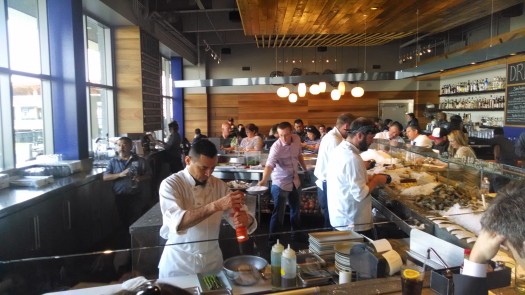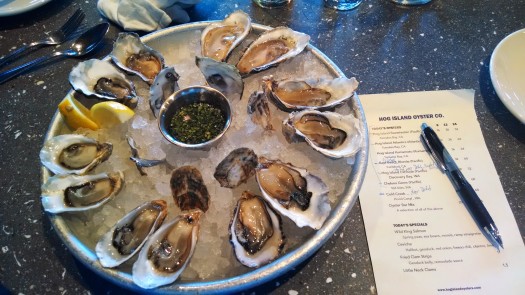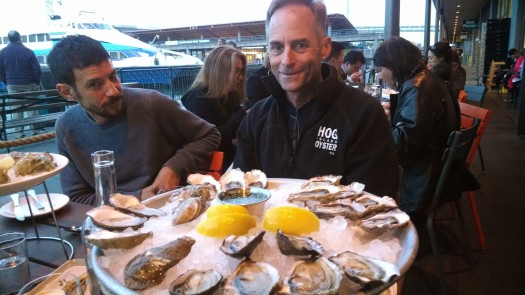Hog Island Oyster Bar, Bigger & Better
May 12, 2014

Shucking up a frenzy in the Ferry Building
The Hog Island Oyster Bar has been an anchor of San Francisco’s Ferry Building since the building reinvented itself as a gourmet mecca with its 2003 renovation. Hard to believe now, but back then the Ferry Building Marketplace was considered such a sketchy concept that its original tenants had opt-out clauses in their contracts. Ten years and ten million oysters later, both the building and the oyster bar are looking pretty darned secure. Hog Island just closed for a few months to take over the seafood market next door (which was the exception that proved the rule of the Ferry Building’s success), doubling in size and expanding its offerings. Now more than ever, it is one of the core San Francisco experiences. When it’s spitting and windy, you sit inside, savoring the bay-facing wall of glass and the shell-embedded bar, and when it’s nice, of course, you sit out on the water, watching the Sausalito ferries come and go while the Bay Bridge soars above you and runs its seizure-inducing light shows. You drink Hog Island’s house oyster wine (a 55/45 mix of Gruner Veltliner and Albarinho from the Edna Valley, near-perfect with any oyster) and eat Hogs of all kinds, all straight out of the seawater tank, which keeps them shockingly fresh (and pushes their salinity to the Tomales Bay extreme, no matter where they originated). These are very good, if very salty, oysters.

Clockwise from the lemon: HI Sweetwaters, HI Atlantics, Carlsbad Blondes, HI Cliffsides, Chelsea Gems, and Cold Creeks
And, I’m excited to say, there are more kinds than ever before. In addition to the flagship Hog Island Sweetwaters, HI currently has its Kumamotos and Atlantics in supply. The Atlantics are insanely good, very savory, with a hint of sweet and a slightly bitter green-tea finish. They are on the small side, but with salt levels this high, that’s all most people can handle, anyway.
The newest Hog on the block is the Cliffside, grown at HI’s new farm in Discovery Bay, Washington, which opens onto the Straits of Juan de Fuca (and thence onto the Pacific Ocean). Disco Bay has long been a favorite spot of mine, both for the Pacific Rim beauty of its hundred-foot cliffs and lonely evergreens, and for the briny flavor of its bivalves. HI Cliffsides fit the bill, adding a tannic spinach/kale note that’s very much in keeping with Tomales Bay’s herbaceous profile; the farms don’t taste worlds apart (but, should one bay or the other be shut down during a storm, it’s nice to have them worlds apart).
Hog Island also carries a select few oysters from other growers. The hits were the Chelsea Gems (crazy sweet, with a strong watermelon-rind finish and gently tumbled cups) and a new one to me: Cold Creeks, from upper Hood Canal (near Dabob Bay). Most upper Hood Canal oysters are big, meaty, and green-shelled, classic life-on-the-beach oysters, but these were Kumamoto-sized and delicate, with a deep-cupped cornucopia shape that usually comes with tumbling. They had the nice ivory color of plump, sweet, glycogen-filled shellfish, a salty-melon flavor, and a very unusual finish almost like aged beef or dried nori. As you can tell, I’m still working on that one. Guess I’ve gotta go back to Hog Island for one more round.

Waterbar’s Erik Hyman and Hog Island’s John Finger compare notes during HIOB’s opening week
« PREVIOUS: New Oyster Festival in Wareham, April 27
» NEXT: Best Song Ever Written About Oyster Restoration
 Recent Posts
Recent Posts
